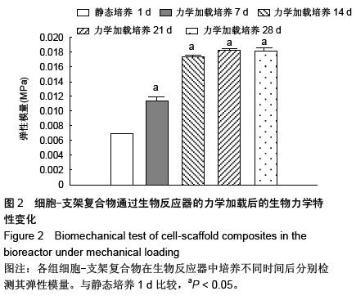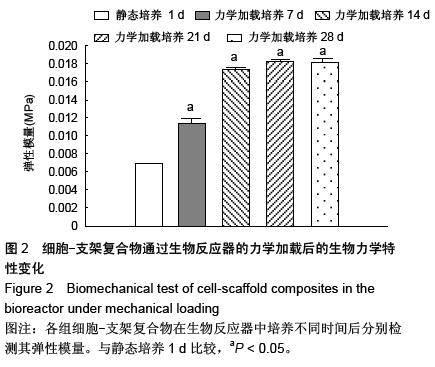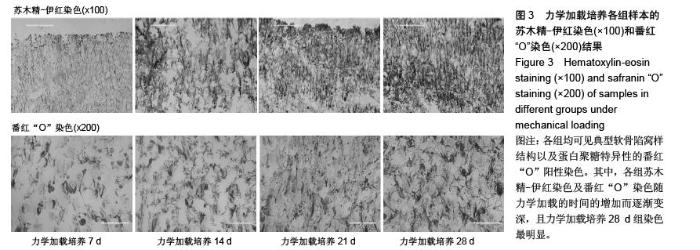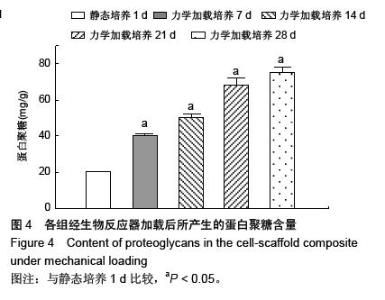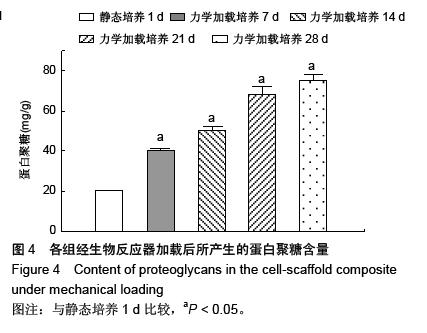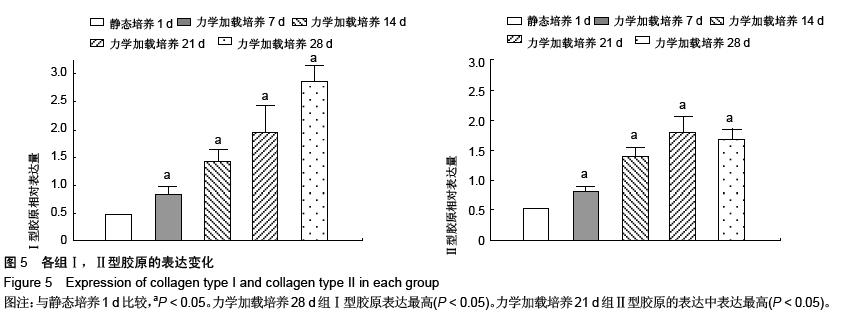| [1] Alan J, Grodzinsky MEL, Moonsoo J, et al. Cartilage tissue remodeling in response to mehanical forces. Annu Rev Biomed Eng. 2000;(2):691-713.
[2] Leonidas G. Alexopoulos LAS, Farshid Guilak. The biomechanical role of the chondrocyte pericellular matrix in articular cartilage. Acta Biomaterialia. 2005;(1):317-325.
[3] Shahin K, Doran PM. Tissue engineering of cartilage using a mechanobioreactor exerting simultaneous mechanical shear and compression to simulate the rolling action of articular joints. Biotechnol Bioeng. 2012;109(4):1060-1073.
[4] Detzel CJ, Van Wie BJ. Use of a centrifugal bioreactor for cartilaginous tissue formation from isolated chondrocytes. Biotechnol Prog. 2011;27:451-459.
[5] Shangkai C, Naohide T, Koji Y, et al. Transplantation of allogeneic chondrocytes cultured in fibroin sponge and stirring chamber to promote cartilage regeneration. Tissue Eng. 2007; 13:483-492.
[6] Kim HW, Han CD. An overview of cartilage tissue engineering. Yonsei Med J. 2000;41:766-773.
[7] Appelman TP, Mizrahi J, Elisseeff JH, et al. The differential effect of scaffold composition and architecture on chondrocyte response to mechanical stimulation. Biomaterials. 2009;30:518-525.
[8] Wang N, Grad S, Stoddart MJ, et al. Particulate cartilage under bioreactor-induced compression and shear. Int Orthop. 2014;38:1105-1111.
[9] Pei Y, Fan JJ, Zhang XQ, et al. Repairing the osteochondral defect in goat with the tissue-engineered osteochondral graft preconstructed in a double-chamber stirring bioreactor. Biomed Res Int. 2014;2014:219203.
[10] Neumann AJ, Gardner OF, Williams R, et al. Human articular cartilage progenitor cells are responsive to mechanical stimulation and adenoviral-mediated overexpression of bone-morphogenetic protein 2. PLoS One. 2015;10(8): e0136229.
[11] Henderson JH, Welter JF, Mansour JM, et al. Cartilage tissue engineering for laryngotracheal reconstruction: comparison of chondrocytes from three anatomic locations in the rabbit. Tissue Eng. 2007;13:843-853.
[12] Schulz RM, Bader A. Cartilage tissue engineering and bioreactor systems for the cultivation and stimulation of chondrocytes. Eur Biophys J. 2007;36:539-568.
[13] Li WJ, Jiang YJ, Tuan RS. Cell-nanofiber-based cartilage tissue engineering using improved cell seeding, growth factor, and bioreactor technologies. Tissue Eng Part A. 2008;14: 639-648.
[14] Valonen PK, Moutos FT, Kusanagi A, et al. In vitro generation of mechanically functional cartilage grafts based on adult human stem cells and 3D-woven poly(epsilon-caprolactone) scaffolds. Biomaterials. 2010;31:2193-2200.
[15] Stoffel M, Yi JH, Weichert D, et al. Bioreactor cultivation and remodelling simulation for cartilage replacement material. Med Eng Phys. 2012;34:56-63.
[16] Kock L, van Donkelaar CC, Ito K. Tissue engineering of functional articular cartilage: the current status. Cell Tissue Res. 2012;347:613-627.
[17] Shahin K, Doran PM. Tissue engineering of cartilage using a mechanobioreactor exerting simultaneous mechanical shear and compression to simulate the rolling action of articular joints. Biotechnol Bioeng. 2012;109:1060-1073.
[18] Pei M, Solchaga LA, Seidel J, et al. Bioreactors mediate the effectiveness of tissue engineering scaffolds. FASEB J. 2002; 16:1691-1694.
[19] Yang Q, Guo Q. A cartilage ECM-derived 3-D porous acellular matrix scaffold for in vivo cartilage tissue engineering with PKH26-labeled chondrogenic bone marrow-derived mesenchymal stem cells. Biomaterials. 2008;29(15): 2378-2387.
[20] Zheng X, Yang F, Wang S, et al. Fabrication and cell affinity of biomimetic structured PLGA/articular cartilage ECM composite scaffold. J Mater Sci Mater Med. 2011;22:693-704.
[21] Yang F, Qu X, Cui W, et al. Manufacturing and morphology structure of polylactide-type microtubules orientation- structured scaffolds. Biomaterials. 2006;27:4923-4933.
[22] Darling EM, Athanasiou KA. Biomechanical strategies for articular cartilage regeneration. Ann Biomed Eng. 2003; 31:1114-1124.
[23] Gokorsch S, Weber C, Wedler T, Czermak P. A stimulation unit for the application of mechanical strain on tissue engineered anulus fibrosus cells: a new system to induce extracellular matrix synthesis by anulus fibrosus cells dependent on cyclic mechanical strain. Int J Artif Organs. 2005;28:1242-1250.
[24] Cartmell SH, Garcia AJ, Guldberg RE. Effects of medium perfusion rate on cell-seeded three-dimensional bone constructs in vitro. Tissue Eng. 2003;9:1197-1203.
[25] Nebelung S, Gavenis K, Luring C, et al. Simultaneous anabolic and catabolic responses of human chondrocytes seeded in collagen hydrogels to long-term continuous dynamic compression. Ann Anat. 2012;194(4):351-358.
[26] Goldstein AS, Helmke CD, Gustin MC, et al. Effect of convection on osteoblastic cell growth and function in biodegradable polymer foam scaffolds. Biomaterials. 2001; 22:1279-1288.
[27] Niklason LE, Abbott WM, Hirschi KK, et al. Functional arteries grown in vitro. Science 1999;284:489-493.
[28] Heath SECaCA. Semi-continuous perfusion system for delivering intermittent physiological pressure to regenerating cartilage. Tissue Eng. 1999;5:1-11.
[29] Chen T, Buckley M, Cohen I, et al. Insights into interstitial flow, shear stress, and mass transport effects on ECM heterogeneity in bioreactor-cultivated engineered cartilage hydrogels. Biomech Model Mechanobiol. 2012;11:689-702.
[30] Mauck RL, Soltz MA, Wang CC, et al. Functional tissue engineering of articular cartilage through dynamic loading of chondrocyte-seeded agarose gels. J Biomech Eng. 2000; 122:252-260.
[31] Altman GH, Martin I, Farhadi J, et al. Cell differentiation by mechanical stress. FASEB J. 2002;16:270-272.
[32] Kupcsik L, Stoddart MJ, Li Z, et al. Improving chondrogenesis: potential and limitations of SOX9 gene transfer and mechanical stimulation for cartilage tissue engineering. Tissue Eng Part A. 2010;16:1845-1855.
[33] Martini F. Fundamentals of anatomy and physiology. Prentice Hall. 2002;77(22):1863. |
